“Mental health is not a destination but a process. It’s about how you drive not where you are going”- Noam Shpancer, PHD
Good mental health makes life easier, it assists people to calm and comfort themselves, and become happy or to cope with any changes or losses. On the other hand, serious mental health issues can impact relationships, education, career, and long-term goals.
As an entrepreneur, if you seek to enter into the mental health industry, creating an app that can reach thousands and millions of such people is important.
But, the question is “How to create a mental health app?”
Well, we have discovered it all for you in this blog.
Are you excited to begin the journey?
Mental Health Apps Overview
Let’s begin with understanding a brief on mental health apps.
A mental health app can be defined as a tool for smartphones, which are designed especially for people to improve their mental well-being.
Mental health apps provide self-directed and remote mental health services that comprise self-monitoring, diagnosis, areas of communication, and treatment. It is developed for individuals at all stages to provide them with their best lives by helping them with any issues concerning depression or any mental health illness.
The apps are developed to assist because a little help can make a big difference in people’s lives.
According to David Mitchell “You say you’re depressed — all I see is resilience. You are allowed to feel messed up and inside out. It doesn’t mean you’re defective–it just means you’re human”
Thus, these apps provide convenience to people where they can get assistance anywhere and anytime.
Do you want to know more about the same?
Let’s evaluate the current market stats about mental health apps in the given section.
Mental Health Apps Market
In the process to create a mental health app, you must be aware of the market competition.
- The amount of people with common mental health issues went up by 20%, that too from 1993 to 2014, among men and women.
- In Ireland, the United Kingdom, and Italy, over half of the respondents stated that they are facing mental stress issues. In the United Kingdom, there are over 51% of respondents stated that they suffer from stress, 19% stated that they suffer from depression, and 8% from anxiety.
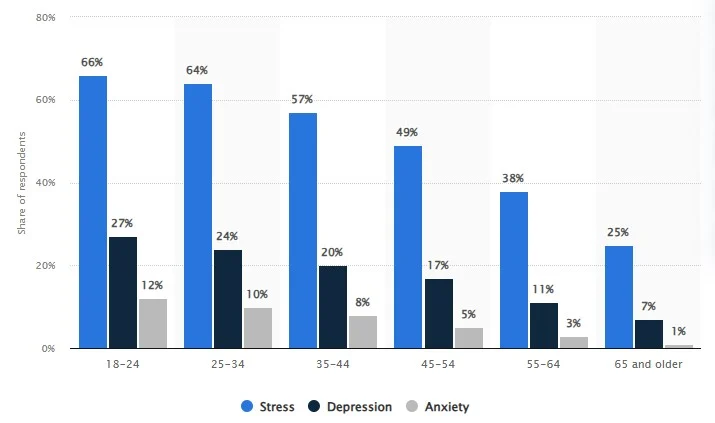
- In the year 2021, there were over 20,000 women and 9,600 thousand men aged 85 years and above have died due to mental health disorders in England and Wales.
- As of the survey in 2023, 31% of respondents between the age group of 26 and 35 have reported that they used tech and apps to get support for their mental health. However, there were only 5% of the population above the age of 66 have used technologies for such purposes.
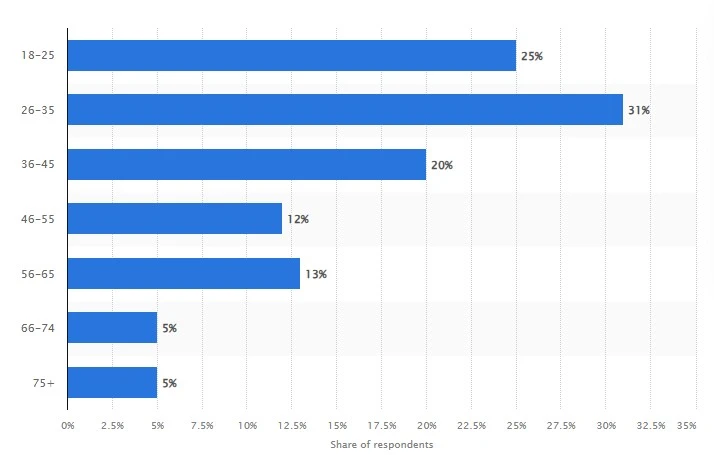
- The global mental health apps market size was estimated at USD 7.38 billion in the year 2024 and is projected to reach from USD 8.50 billion in the year 2025 to USD 17.52 billion by the year 2033 by exhibiting a CAGR of 9.5% during the year 2025- 2033.
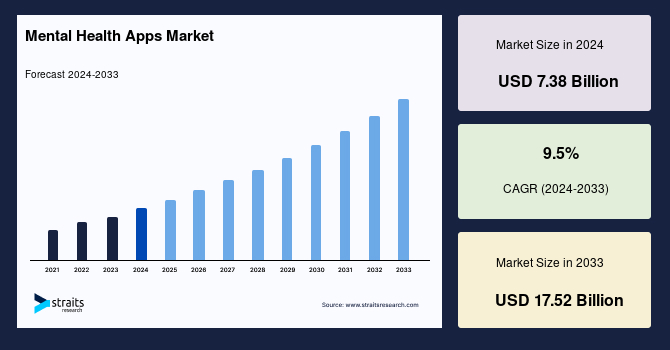
- In the year 2024, the Canadian-based BetterSleep app was the most downloaded meditation app with approx. one million thousand downloads in the examined month. While Calm ranked second.
Well, you can too make your recognition in this market, by connecting with a wide audience and developing an engaging mental health app.
Are you confused about the why develop a mental health app?
Let’s find it out all in the next section.
Reasons to Develop a Mental Health App
Apart from the growing market for mental health apps, many other reasons need to be considered.
Let’s examine them all below.
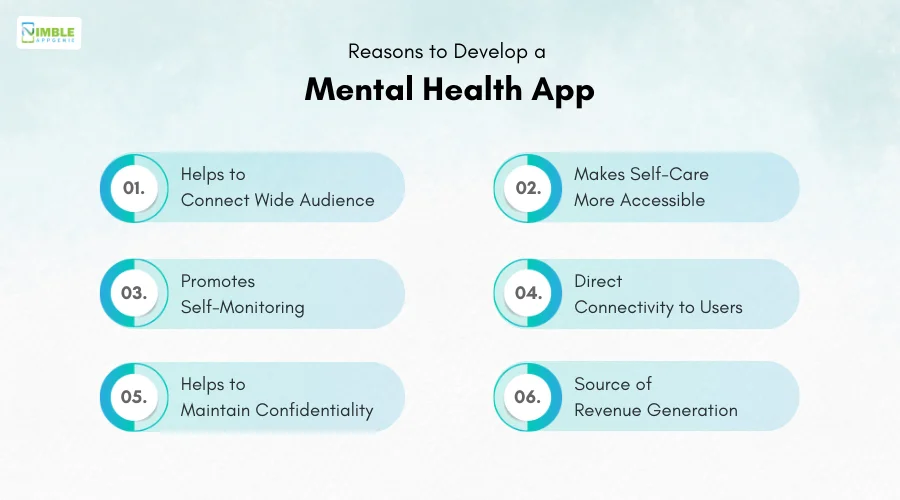
♦ Helps to Connect Wide Audience
When you seek to enter into the health industry, it’s essential to reach and engage a wide audience to help them with mental health issues. Through an app, users can get more access to mental well-being tools.
This will help you to know and learn about the wide audience related to their preferences over mental health.
♦ Makes Self-Care More Accessible
You can make self-care more accessible by incorporating self-care activities over the app. Thus, building a mental health app can be helpful to you for reaching out to the audience, and enabling you to reduce stress, as well as enhance emotional well-being to build resilience.
After COVID, it has become essential to prioritize self-care among humans and an app can add value.
♦ Promotes Self-Monitoring
Through creating self-monitoring apps, you can proceed with providing the users with self-management strategies that can help reduce delays in getting mental health aids on time. It assists the users to get medical aid and evaluate their mental health effectively.
It helps the users to identify the requirements of eating well, sleeping well, and getting enough exercise.
♦ Direct Connectivity to Users
With an app, you can directly connect with the users on time. When it comes to mental health, it’s all about time and guidance in the right scenario. By eliminating any third party, the users can directly connect with doctors and psychiatrists on time.
This will reduce the rate of suicides and will keep the sensitive data among two groups only.
♦ Helps to Maintain Confidentiality
A mental health app will help to keep the information confidential. This will build the users’ trust in the brand and engage them more. However, when it comes to a website, the users will be required to search for contact information and then they can proceed to find assistance.
Thus, an app will be more effective when it comes to mental health.
♦ Source of Revenue Generation
If you think of business purposes, building an app can be effective in generating enough revenue from diversified sources. There can be multiple sources of monetization strategies you can implement such as in-app purchases, in-app advertising, data monetization, and many others.
Thus, creating a mental health app can be a great source of generating revenue.
After considering these reasons to create a mental health app, let’s evaluate different types of mental health apps in the following section.
Types of Mental Health Applications
When you proceed with mental health app development, you should identify and consider diversified types.
Let’s learn them all here.
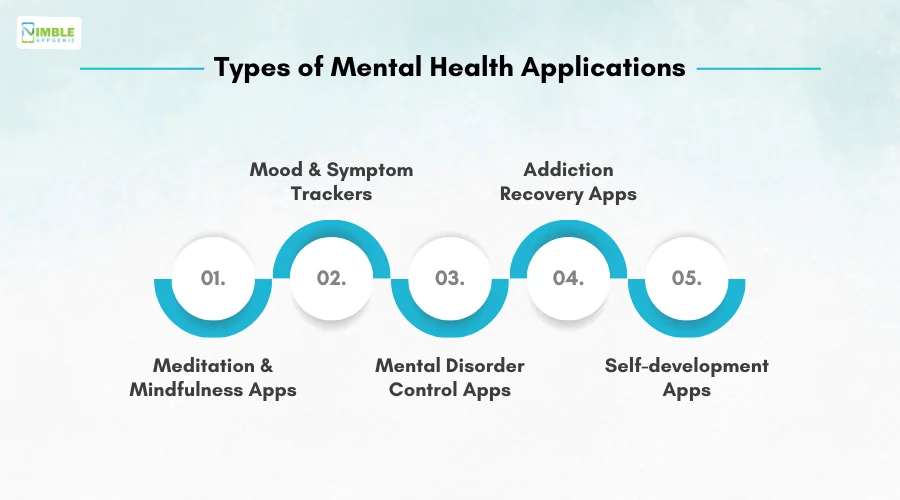
1. Meditation and Mindfulness Apps
Meditation and mindfulness apps assist in learning and mastering different meditation skills including focused deep, being present, and mental clarity. Such app interventions display efficacy in enhancing a range of clinical outcomes including depression and anxiety.
2. Mood and Symptom Trackers
Through mood-tracking apps, you can identify patterns in moods along with thought patterns including depression. This will help evaluate the current mental health of an individual and provide them assistance according to symptoms and moods.
3. Mental Disorder Control Apps
Mental disorder control apps are the types of mental health apps that are designed to help people enhance their mental well-being. Such apps are developed to promote wellness via mindful practices like meditation.
4. Addiction Recovery Apps
These apps are designed to assist users with sobriety. Such mental health apps are developed to assist users in avoiding their drug intake or smoking habits. Such apps work for people to identify their addiction, and then help them to control it adequately.
5. Self-Development Apps
Self-development apps are completely developed to focus on individual health. Here the users can evaluate diversified skills to improve themselves. Personality development apps offer guided meditations along with mindfulness exercises for enhancing focus and reducing stress.
Well, after evaluating the type of mental health app that you can make, let’s examine the potential features to include within the same through the following section.
Key Features to Include in Your Mental Health App
Features are the blood of an app, and it’s essential to evaluate valuable elements to enhance its overall functionality.
What are the key features to include within mental health apps?
Here’s the list of top healthcare app features to consider.
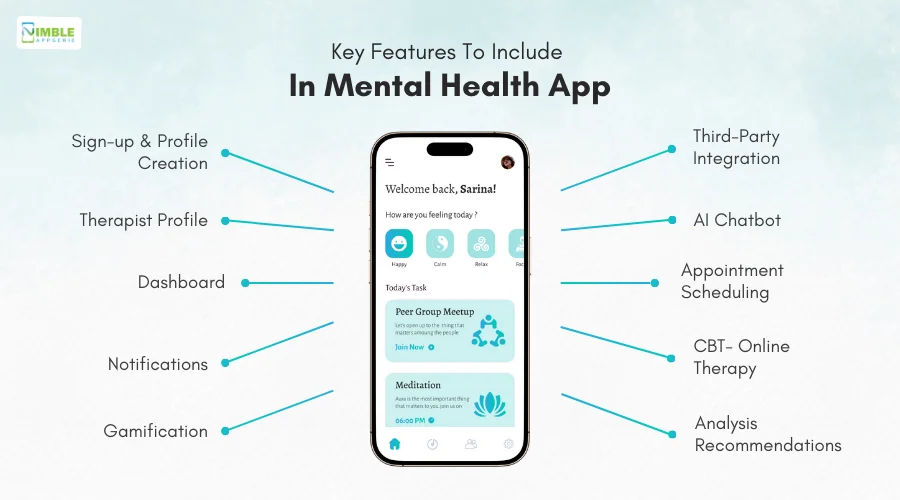
1] Sign-up and Profile Creation
The users can sign up for the app, after downloading it. Here they can create their profile by adding all the essential details such as name, address, type of medical health illness, or adding documents of any medical history.
2] Therapist Profile
The profile page should be informative, yet simple. This should display all the essential information of the therapist such as their experience, name, qualifications, etc. It will be effective for the users to decide whether they can proceed with the appointment or not.
3] Dashboard
After logging in to the profile, the users can see their customized dashboard containing all the essential information about them. It will be effective for the users to check for their current appointments and the latest medical history related to mental health.
4] Notifications
Adding notifications to the app provides recommendations for encouraging self-monitoring and providing alerts to the users about their mental health and activities that they are required to perform at that time.
5] Gamification
Gamification is an important feature that retains and engages the users in the long run. Here mental care can be further transformed into fun with games. This will keep users aware of their mental health and engage them to achieve short-term goals related to health via games.
6] Third-Party Integrations
Integration with third-party services like payment or video calling APIs can be an important feature to add while building a mental health app. This feature can assist the users to remain in connection with potential doctors or assistance on time.
7] AI Chatbot
Adding AI features in the app such as chatbot can assist the users to get an aid on time. Here the users can type their query and the chatbot will provide them with all the related help, anytime and anywhere. If required, the chatbots can connect them to the doctors as well.
8] Appointment Scheduling
With this feature, the users can book or schedule appointments as and when required. Users can set a date and time over the app to book it. Along with this, users can connect with the therapist, easily, and even the feature supports calendars to mark dates.
9] Cognitive Behavioral Therapy (CBT)-Online Therapy
A feature of online therapy can be found in mental health apps where the users can go for the type of therapy over the app without even visiting the doctor or psychiatrist. This feature is useful for assisting them to find suitable therapists even without waiting in a queue.
10] Analysis and Recommendations
With the help of AI, the mental health apps assist users to get effective recommendations. AI is useful for analyzing the users’ data and then providing them with recommendations based on their mental health issues.
Considering these features can be helpful for you to have an idea about the app and the types of elements to include for enhancing its functionality.
Till now, we have analyzed an overview and a brief on mental health apps, their market stats, reasons, types, and features.
Well, now it’s time to discover “How to make a mental health app?”
Steps to Develop a Mental Health App
What are the steps to build a mental health app?
To create a health app, it’s vital to learn and evaluate the right steps that will help you plan and make related strategies.
Let’s examine the strategies below.
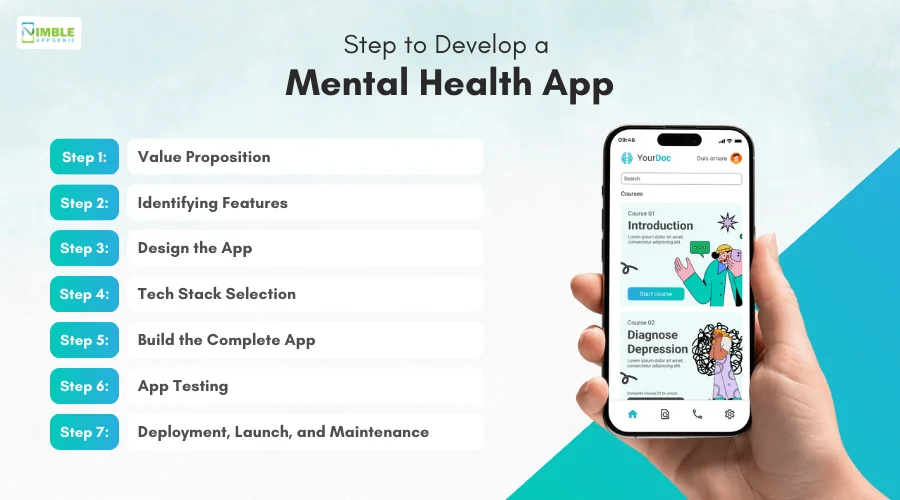
Step 1: Value Proposition
You should know and evaluate the value of your app idea in the competitive market. It is all about displaying a concise statement of the diversified benefits that you can offer to the targeted clients.
Here, it’s significant to conduct market research where you should identify the prospective needs of the users in detail. It is an opportunity to identify the market gap that exists in the market after evaluating the competitors’ strategies and how they perform well.
Here you can identify, the purpose of bringing your app vision to the market. Analyzing the value of your app can be effective in validating the requirements of the idea and how helpful it will be for potential users.
Step 2: Identifying Features
It’s essential to identify the types of features to include within the app whether they are basic or advanced. You should be aware of the diversified features that can make your app valuable and engaging.
The features represent your app, thus, it must be practical for addressing users’ issues related to mental health. You should make the features an identification of your business and brand.
This will help serve the purpose of the app after determining the need for its existence. Features should be engaging and attractive to retain users. Additionally, you should not include too many features within the app because it will confuse the users.
Step 3: Design the App
You need to create the UI/UX of an app, where it’s essential to evaluate the color palate, theme, fonts, and typography. Under this step, you should visualize the app with all the important features.
Here, it’s vital to create a wireframe and prototype that will be effective in making the layout content and functionality over a page which takes into account the user journeys, and user needs.
This will be effective in framing the infrastructure of the app and creating its structure where the complete app can be designed.
Step 4: Tech Stack Selection
Selecting the suitable mobile app tech stack can be useful in defining the type of programming languages, databases, servers, development tools, or frameworks for mental health app development.
For the front-end technologies, you can select ReactJS, Angular, CSS, JavaScript, and HTML. Other than this, the back-end technologies can be Laravel, Django, Python, Java, and Ruby.
Well, before selecting the technologies, it’s essential to evaluate the type of platform where you are required to launch the app. Here the platforms can be Android, iOS, or Hybrid depending on the targeted audience.
Step 5: Build the Complete App
Now, it’s time to combine all the steps and build the app of your dreams. When it comes to the mental health app, you need to ensure that it contains all the essential features that might enhance the functionality.
You need to hire mobile app developers to successfully convert your idea into reality. Here you should discuss all the possibilities of changes and steps to be taken with the developers.
This will help you visualize the complete app and you can feel secure with the data and information to be passed on to the developers.
Step 6: App Testing
Mobile app testing is all about identifying the errors and issues that can impact complete productivity and operations.
An error in your mental health app is enough to bounce the interest of the users to the competitors. It’s an important step, where you can mention utilizing effective tools and techniques.
The testing of your mental health app comprises functional compatibility, usability, and installation tests for quality analysis. This is an important step before you continue with the launch of your mental health app.
Step 7: Deployment, Launch, and Maintenance
You need to deploy the apps over the defined platforms. Now, it’s time to launch the app successfully.
Well, now let’s discuss about after-app development criteria for app maintenance. Here all you need is to connect with potential app maintenance services. They will help you with the tools to maintain the app.
Identifying bugs and errors, evaluating significant failures, and reducing downtime are all the app maintenance importance to be considered to address potential issues.
Considering this list of steps, you can build an engaging health app. If you are still puzzled, let’s evaluate the top mental health apps in the following section.
Top Mental Health Apps in the Market
What are the top mental health apps to be considered?
When you enter the mental health apps industry, it’s essential to evaluate the competitors present in the market.
Let’s learn them all here.
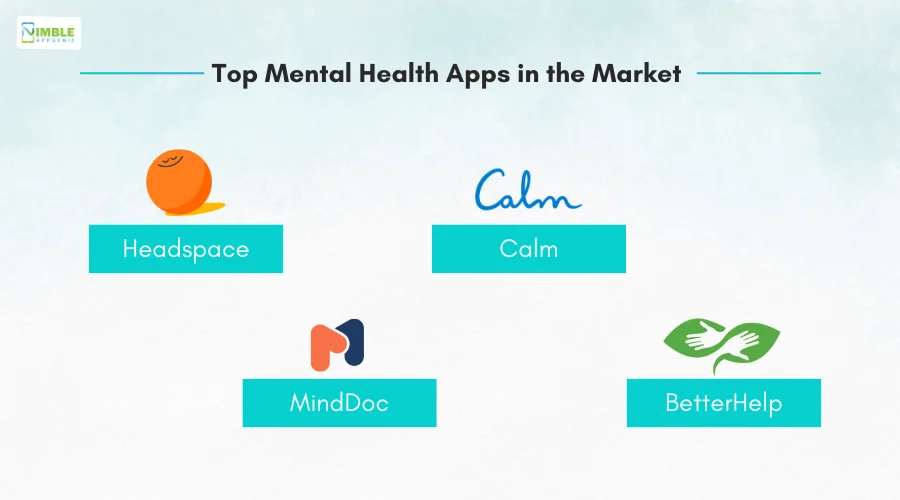
► Headspace
The Headspace app is useful in providing mindfulness tools for everyday life, comprising meditations, sleep casts, focus exercises, and mindful movement.
The app helps users to reduce their stress, sharper focus, reduce burnout, and enhance symptoms of depression. To develop an app like Headspace, you need to evaluate the right number of steps and features.
► Calm
Calm is among the second favorite apps for meditation. It is a mindfulness app for newcomers and meditation enthusiasts. This app can be useful in assisting users to find inner peace and to evaluate stress in an individual’s life.
You can build an app like Calm, with the right steps and connect to a potential team of developers.
► MindDoc
MindDoc acts as a valuable tool for users to prevent any mental disorders and strengthen the practice of self-care. This app can be useful in actively encouraging the users with the important symptoms which further can cause a larger impairment.
It serves well as a companion in the user’s journey of mental health. Additionally, the app offers support for various aspects of symptom management, mindfulness, coping with painful emotions, and time management.
► BetterHelp
BetterHelp includes filling out the questionnaire and then helping the users to evaluate their mental health. By answering a set of questions, the users can identify the symptoms that further can lead to anxiety, stress, or depression.
It can be seen as a counseling platform that assists users in accessing online therapy within the comfort of their own homes.
Well, now that we know about our competitors, why shouldn’t we take a look at the essential resources we need to create a mental health app?
Are you ready to find resources? Let’s proceed further.
Mental Health App Development Cost
What’s the cost to develop a mental health app?
On average, the cost to create a mental health app ranges from $15,000 to $80,000 depending on different factors such as the type of app, features included, complexity of features, design, technology stack, and much more.
In the next section, you can explore more about the factors impacting the cost to create a health app.
Factors Impacting the Cost to Create a Mental Health App
After evaluating the cost, let’s examine the factors impacting it.
In this section, you will evaluate diversified factors affecting the overall cost to create a mental health app.
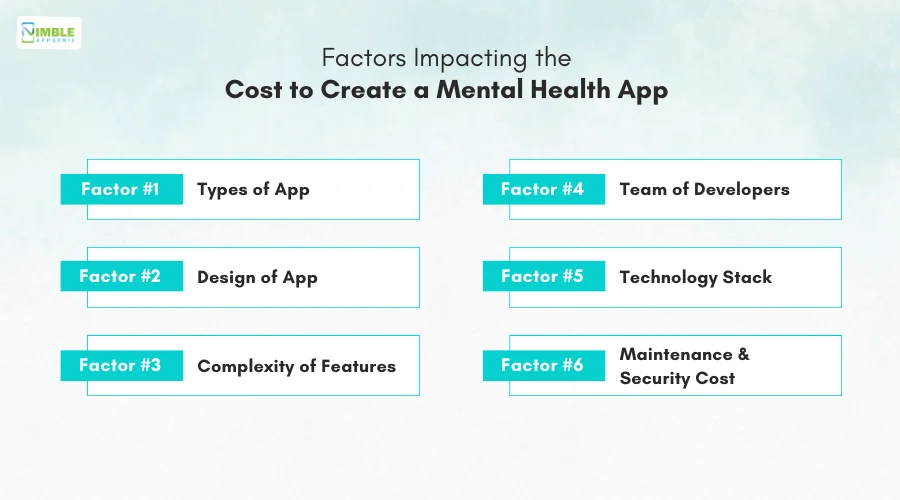
-
Types of App
Selection of the types of apps is a crucial segment where the user needs to evaluate the kind of mental health application. There are many types of apps that you need to be concerned about such as meditation apps, mood and symptom trackers, mental disorder apps, and self-development apps.
The complexity of apps will increase the cost of developing them. Thus, the type of mental health apps that you select will have a large impact on cost. Here the cost can vary from $2000 to $20,000. Depends on the types you select.
-
Design of App
The type of design you select for your app such as its color, theme, and typography will impact the complete cost of building it.
The cost to design an app can vary from $5000 to $30,000 depending on different parameters including the complexity of the design. Here the visual designs and UI elements including icons, and images, can enhance the overall cost of building it.
-
Complexity of Features
The complexity of features comprises adding security panels, intuitive navigation, feedback form, personalization, and the implementation of AI features. It assists the users in managing as well as navigating the large data sets.
Here the cost can vary from $5000 to $20,000 depending on the complexity of diversified features. You should note that the more features that you include in the app will result in more development time and resources.
-
Team of Developers
The cost to hire mobile app developers will enhance the overall cost of mental health app development. Under this phenomenon, you are required to evaluate two diversified factors such as location and expertise of the members.
Under this factor, the cost can vary from $15,000 to $80,000 for experts belonging to Asian regions. However, if you hire developers from the United States or Europe, it can cost from $30,000 to $150,000 for highly professional experts.
-
Technology Stack
The type of technology selection such as including the updated tech stack will raise the cost to build a mental health app. If you are worried that the technology advancements can lead to an increase in the complete cost to create a mental health app, then it’s important to evaluate that it will help you to sustain long-term goals.
Here the tech stack cost can vary from $10,000 to $30,000 depending on the type you select. Additionally, tech stack selection will rely on the type of platform you select to launch your app.
-
Maintenance and Security Cost
A mental health app requires high data security because your app will include sensitive information and details about the users. Thus, effective mobile app security will require a high cost.
Along with the security cost, maintenance cost is another perspective to not compromise. After launching the app, it’s essential to maintain your mental health app. Thus, keeping a cost aside for the same is essential.
These are the significant factors that should be noted for building a mental health app. Now, that we covered the aspects of cost, it’s time to evaluate the monetization strategies to cover this cost.
The following section can be helpful for the same.
Monetization Strategies for Mental Health Apps
What are the top monetization strategies that can be useful to cover the cost invested to develop a mental health app?
Here is the list of top app monetization strategies to consider.
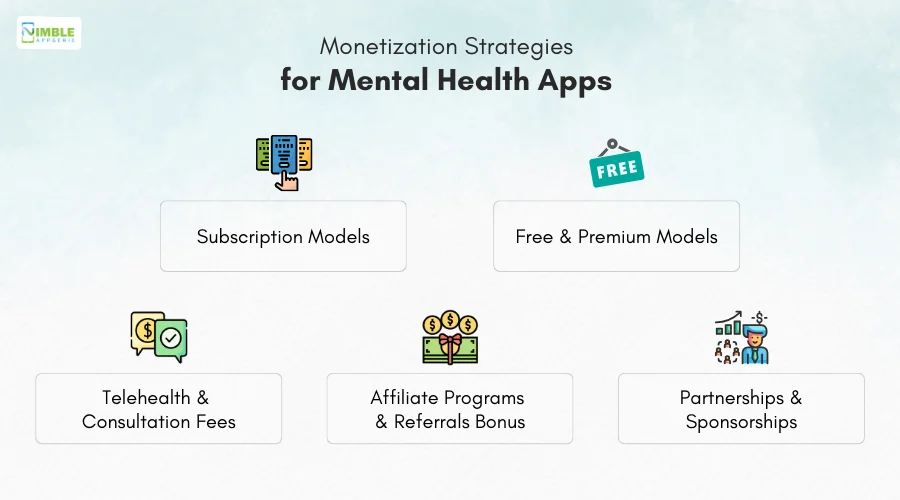
➤ Subscription Models
The majority of mental health apps utilize subscription models, where they charge from the doctors and not from the patient to be on the top list of psychiatrists.
This model helps doctors to schedule appointments with patients to enhance the healthcare community. This method will be effective in providing you with a permanent solution to earn money.
➤ Free and Premium Models
Under the free and premium monetization strategy, the developers can make two versions of the app one is free for the users while the other is paid. Here the free version of the app will be effective in attracting new users over the platform.
However, the premium version can engage users in the long run and help you to earn permanent revenue.
➤ Telehealth and Consultation Fees
You can charge the users for providing them the facility of telehealth, where they can conversate with the doctors over video or audio calls. Additionally, you can keep a percentage of consultation fees as a commission.
This will help you earn a regular amount of revenue from the app.
➤ Affiliate Programs and Referral Bonus
Affiliate marketing is another strategy that is utilized by the developers to monetize the app. Here you can promote other brands’ products and services over your app via links or using a referral bonus strategy.
Under this strategy, you need to keep transparency with the affiliate programmers about the types of links that they are using for promoting, because you cannot take the risk of losing potential users.
➤ Partnerships and Sponsorships
With this model, you are required to collaborate with third parties who are interested in promoting the services via the app. Here you can collaborate with a pharmacy or even a medical center within your area.
This will assist you in providing convenience to the users for scheduling appointments and getting pharmacy assistance over the same platform.
These were the monetization strategies to consider for covering the cost to build a mental health app.
Now, as we covered an important resource as cost, let’s evaluate the time taken to create a mental health app in the following section.
How Long Does it Take to Create a Mental Health App?
How long does it take to build a mobile app?
Here’s a table defining it all.
| Process | Time Required |
| Conceptualization | 1-2 Months |
| App Design | 1-2 Months |
| Selection of Technology Stack | 1-2 Months |
| Build the App | 2-3 Months |
| Testing | 1-2 Months |
| Launch, Deployment, and Maintenance | 1-2 Months |
| Total Time Required | 7-13 Months |
This time can vary depending on the developers, their skills, and the objective of the app.
Well, after evaluating the resources as cost and time, let’s identify the types of challenges that you might face while building a mental health app.
The following section will describe it all.
Challenges While Building a Mental Health App
What are the top challenges that your app can face during development?
Here’s to check for the mistakes to avoid while building a mental health app.
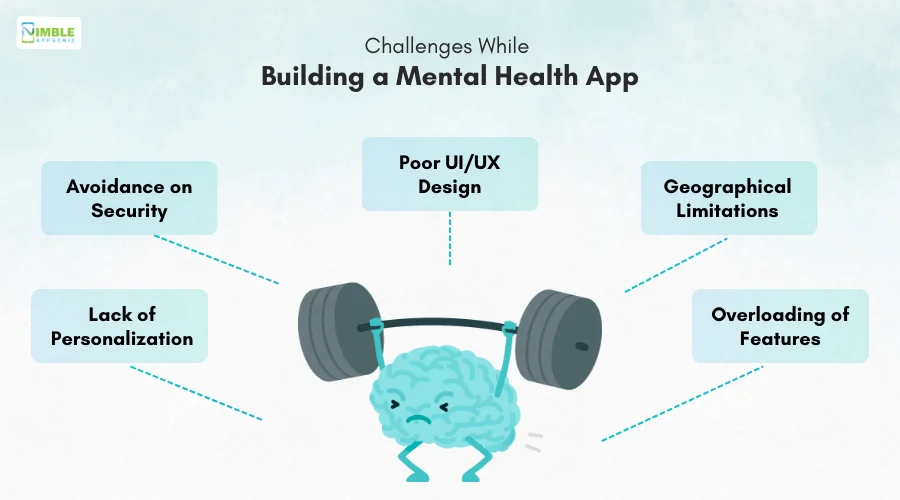
♦ Lack of Personalization
If you dream of entering in healthcare industry, personalization is the topmost element. Losing personalization will result in lacking to build a long-term interaction with the users.
♦ Avoidance of Security
Poor security will hamper the user’s trust in the app. This will have a large impact on your brand’s image as well. A lack of security will invite the cyberattackers to abolish your app’s existence from the competition.
♦ Poor UI/UX Design
A lack of intuitive and attractive app design can lead to poor user experience. Here users might face difficulty in addressing the objective for which they have downloaded your app.
♦ Geographical Limitations
It’s important to determine the area or region you will cover with your mental health app. Avoidance of geographical limitations can impact your connection with users.
♦ Overloading of Features
Adding too many features within the mental health app can impact the user’s experience. Too many features in an app will confuse the users and it can even increase the chances of an app crash.
These are all the issues that you can overcome by adding important practices while building a mental health app.
If you are still confused about app development, connecting with an experienced company can be helpful.
How Can Nimble AppGenie Help in Mental Health App Development?
Searching for an experienced company to build your dream app?
Nimble AppGenie can assist you in the process of building an app, launching it, and even maintaining it.
We are the best Healthcare App Development Company that delivers promises, quality, and integrity. Our team is ready to help you with all the essential processes, guidance, and techniques that will make you lead the industry in simple steps.
Our Experts know well the process of including the right steps to create a mental health app. Thus, connecting with us will provide severe benefits.
Conclusion
While building a mental health app and entering the industry, you should be aware of crucial steps. It’s essential to know about the market and to analyze the current competition. Furthermore, you should include the types of features for successfully leading the industry. Here the features can be such as a dashboard, therapist profile, notifications, and scheduling appointments.
Additionally, here the cost to make a mental health app can vary depending on diversified factors such as complexity of features, app design, tech stack, maintenance, and security. You can include diversified monetization strategies such as telehealth, subscription fees, free and premium models, affiliate programs, partnerships, and sponsorships.
Other than this, you can overcome the challenges by adopting important practices. Connecting with an experienced company can be helpful.
FAQs
There is a series of steps that you are required to undertake for building a mental health app. Let’s evaluate them all below.
- Step 1: Value Proposition: Here you need to identify the value of your app in the competitive market. Additionally, you need to identify the current market and industry.
- Step 2: Selection of Features: It’s essential to select effective features that will accompany the goal of creating a mental health app.
- Step 3: App Design: Under this step, it’s essential to add a design for your app that needs to be attractive for creating a first impression.
- Step 4: Tech Stack: Here is all you require to build a great tech stack that will support the features and will be effective for your app.
- Step 5: Testing: Now, it’s time to conduct rigorous testing for your app. You should include different types of testing under this phenomenon.
- Step 6: Launch, Deployment, and Maintenance: You can place your app over the targeted platform, launch it, and adopt different maintenance tools to update it.
These are all the important steps to build mental health apps.

Niketan Sharma is the CTO of Nimble AppGenie, a prominent website and mobile app development company in the USA that is delivering excellence with a commitment to boosting business growth & maximizing customer satisfaction. He is a highly motivated individual who helps SMEs and startups grow in this dynamic market with the latest technology and innovation.
Table of Contents




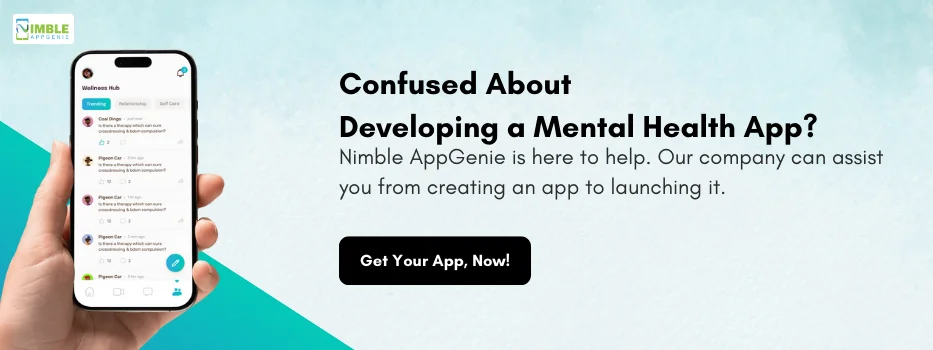
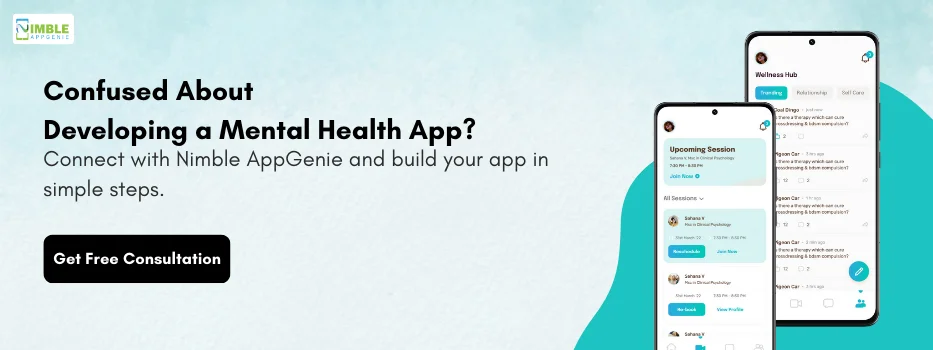
No Comments
Comments are closed.